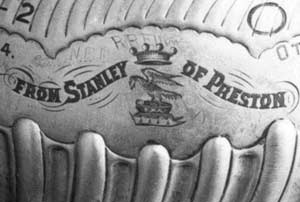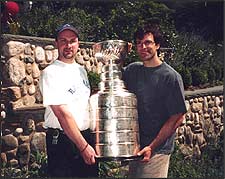 |
| Lord Stanley of Preston |
(Wednesday, June 25) -- Who was this Stanley guy and why is hockey's most prestigious trophy named after him?
Frederick Arthur Stanley was born in London, England on January 15, 1841, the younger son of three-time Prime Minister of England, Edward George Geoffrey Stanley, the Fourteenth Earl of Derby. Educated at Eton and later at military college, Frederick Stanley received his commission in the Grenadier Guards, but opted for a political career shortly afterwards. He was elected as a Conservative Member of Parliament for Preston, and later represented North Lancashire and Blackpool in the House of Commons. Lord Stanley was a Member of the British Parliament between 1865 and 1886, including a term as Secretary of State for the Colonies in 1885 and 1886. From 1886 to 1888, Stanley was president of the Board of Trade.
On June 11, 1888, Lord Stanley succeeded the Marquis of Lansdowne as the sixth Governor-General of Canada, appointed by England's reigning monarch, Queen Victoria. Stanley's full title was the Right Honourable Sir Frederick Arthur Stanley, Earl of Derby, Baron Stanley of Preston, in the County of Lancaster, in the peerage of Great Britain, Knight Grand Cross of the Most Honourable Order of the Bath. Although Lord Stanley lived in the official residence of the Governor-General, Rideau Hall, upon his move to Ottawa, he built a large summer home called Stanley House in order to indulge his love of fishing. It was located on the Baie des Chaleurs near the mouth of the Grand Cascapedia River on the Gaspe Peninsula. Today, Stanley House is a charming bed and breakfast destination.
Lord Stanley's term in office as Governor-General was uneventful, with the exception of his incomparable legacy to hockey. While in Canada, Stanley's children discovered exciting new winter pursuits, including snowshoeing, tobogganing, skating and playing hockey. His sons Algernon and Arthur formed a competitive hockey club called the Rideau Rebels, while his daughter Isobel was one of the first female hockey players in Canada. On March 18, 1892, the Governor-General asked Lord Kilcoursie, a vice-regal aide who played on the Rideau Rebels with Stanley's sons, to read a letter on his behalf to the Ottawa Athletic Association.
'I have for some time been thinking that it would be a good thing if there were a challenge cup, which would be held from year to year by the leading hockey club in the Dominion. Considering the general interest which hockey matches now elicit, and the importance of having the game played fairly and under rules generally recognized, I am willing to give a cup which shall be held from year to year by the winning club.'
 |
| A close-up of the original Stanley Cup. Note the faint etchings on the original bowl. Apparently, some players that had won the trophy before the tradition of inscribing entire rosters on the bowl took it upon themselves to etch on their own names . |
Lord Stanley's offer was enthusiastically accepted, and he subsequently requested one of his aides, Captain Colville, to purchase an appropriate trophy. Known originally as the Dominion Hockey Challenge Cup, the trophy was purchased for ten guineas ($48.67 at the time) and quickly became known as the Stanley Cup. The silver bowl was created in Sheffield, England but purchased in London, England and stood 7.28 inches tall and 11.42 inches in diameter. Today, this original Stanley Cup is kept on permanent display at the Hockey Hall of Fame.
Lord Stanley insisted that the Cup remain a challenge trophy, presented for the amateur championship of Canada, and never become the property of any one team. The first Stanley Cup winner was the Montreal Amateur Athletic Association in 1893. In 1910, after having being awarded to both amateur and professional teams, the Stanley Cup was awarded exclusively to professional teams. From the National Hockey League's formation in 1917 until 1926, the magnificent trophy was awarded to the winner of a playoff between the NHL and the Pacific Coast Hockey League. When the PCHL dissolved in 1927, the Stanley Cup was presented exclusively to NHL playoff champions.
Lord Stanley never witnessed either a championship hockey contest or his namesake trophy presented to a championship team. Stanley's term as Governor-General was scheduled to end in September 1893, however, in April of that year (midway through the hockey season), Stanley's brother, the Fifteenth Earl of Derby, died. Lord Stanley resigned the Governor-Generalship and returned home to England on July 15, 1893 to become the Sixteenth Earl of Derby. In 1893, he was appointed president of University College and when the University of Liverpool was established in 1903, Lord Stanley became the university's first Chancellor. Between 1895 and 1896, Lord Stanley served as the First Lord Mayor of Greater Liverpool and also later served as Mayor of Preston. Lord Stanley died at Knowsley, in Lancashire, on June 14, 1908.
Lord Stanley of Preston had no comprehension of the immense impact his gift would have. In 1945, the donation of the Stanley Cup earned its benefactor entrance to the Hockey Hall of Fame, as a builder of the sport -- one of the fourteen men inducted into the Hockey Hall of Fame that initial year.
 |
| Three-time Stanley Cup winner Scott Niedermayer brings the last piece of decoration to his neighborhood party. |
2,200 names of individuals are engraved on the Stanley Cup. Some players, like Henri Richard, are engraved multiple times - eleven in the case of the 'Pocket Rocket.' By the end of the summer, the names of the 2002-2003 New Jersey Devils will be added to that total. The Devils' Scott Niedermayer is one of those with multiple appearances on the Stanley Cup. As of Monday, his name appeared twice, but he knows a third will be added in September.
Scott enjoyed a day with the Stanley Cup on Monday. Although not his official twenty-four hour visit, which will likely involve a visit to Cranbrook, British Columbia later this summer, Scott and his wife hosted a neighbourhood party in their Montclair, New Jersey backyard. The Niedermayers provided food, drink and a visit with the Stanley Cup to anyone from the area who wanted to stop by. The kids took special delight in the visit, and Scott had Devils' posters, t-shirts and mini-sticks on hand for the youngsters, who were only too happy to get a treat signed by one of New Jersey's stars. Jay Pandolfo and his ladyfriend came by to visit the neighbourhood party, too.
Visit the Stanley Cup Journal again on Friday and smile at some of the shenanigans involving shinny's shiny Cup.
Kevin Shea is a hockey journalist and historian based in Toronto.
|